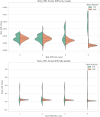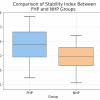Comparison of corticomuscular coherence under different balance paradigms in individuals with and without forward head posture
- PMID: 40594912
- PMCID: PMC12215537
- DOI: 10.1038/s41598-025-06603-8
Comparison of corticomuscular coherence under different balance paradigms in individuals with and without forward head posture
Abstract
A prospective case control investigation was conducted to assess corticomuscular coherence (CMC) under different balance conditions in order to identify alterations that may arise due to forward head posture (FHP). Sixty-four participants (between the ages of 18-25) were recruited for this study. Participants were free from any musculoskeletal symptoms and matched for relevant demographic variables. Participants were assessed for FHP using the craniovertebral angle (CVA) and separated into either the normal head posture (NHP) group by CVA > 50° or the FHP group by CVA < 50°. Participants were evaluated using the Biodex balance system while both EEG and EMG signals which were acquired simultaneously to investigate CMC. Balance was investigated under four conditions increasing in challenge: (1) standing with eyes open, (2) standing with eyes closed, (3) unstable standing with eyes open with the Biodex set on level 8, and (4) unstable standing with eyes closed with the Biodex at level 8. In addition to recording delta, beta, theta, alpha, and gamma waves, we calculated both peak and average coherence values from the CMC analysis. Statistically significant differences were identified for the FHP group vs. the NHP group for both peak (p < .001) and average CMC values (p < .001) and for the interaction of balance difficulty (stage 1 vs. stage 4), p < .01. Similarly, all brain waves (delta, beta, theta, alpha, and gamma) demonstrated statistically significant differences between the NHP and FHP groups (p < .001) and for increasing balance difficulty across the four stages, p < .05. This study demonstrates that FHP is associated with a significant elevation of CMC, a unique compensatory burden on the brain, particularly during physically challenging balance tasks.
Keywords: Balance; Corticomuscular coherence; Forward head posture; Sagittal balance.
© 2025. The Author(s).
Conflict of interest statement
Declarations. Competing interests: D.H. is the CEO of Chiropractic BioPhysics and lectures on rehabilitation methods, and distributes products for patient rehabilitation to physicians in the USA; none of these products were used in this manuscript. All the other authors declare that they have no competing interests. All the other authors declare that they have no competing interests. All other authors have nothing to declare. Informed consent: Informed consent was obtained from all participants involved in the study, and written informed consent was obtained from participants whose pictures were included in the paper. Institutional review board statement: The research was approved by the Research Ethics Committee at the University of Sharjah (Reference number: Rec-24-03-10-01-PG).
Figures










Similar articles
-
Effect of adding global postural reeducation to kendall exercises for treating asymptomatic forward head posture: A single-blinded randomized controlled trial.J Bodyw Mov Ther. 2025 Jun;42:938-947. doi: 10.1016/j.jbmt.2025.01.039. Epub 2025 Feb 6. J Bodyw Mov Ther. 2025. PMID: 40325777 Clinical Trial.
-
Systemic pharmacological treatments for chronic plaque psoriasis: a network meta-analysis.Cochrane Database Syst Rev. 2021 Apr 19;4(4):CD011535. doi: 10.1002/14651858.CD011535.pub4. Cochrane Database Syst Rev. 2021. Update in: Cochrane Database Syst Rev. 2022 May 23;5:CD011535. doi: 10.1002/14651858.CD011535.pub5. PMID: 33871055 Free PMC article. Updated.
-
Systemic pharmacological treatments for chronic plaque psoriasis: a network meta-analysis.Cochrane Database Syst Rev. 2017 Dec 22;12(12):CD011535. doi: 10.1002/14651858.CD011535.pub2. Cochrane Database Syst Rev. 2017. Update in: Cochrane Database Syst Rev. 2020 Jan 9;1:CD011535. doi: 10.1002/14651858.CD011535.pub3. PMID: 29271481 Free PMC article. Updated.
-
Signs and symptoms to determine if a patient presenting in primary care or hospital outpatient settings has COVID-19.Cochrane Database Syst Rev. 2022 May 20;5(5):CD013665. doi: 10.1002/14651858.CD013665.pub3. Cochrane Database Syst Rev. 2022. PMID: 35593186 Free PMC article.
-
Interventions for eye movement disorders due to acquired brain injury.Cochrane Database Syst Rev. 2018 Mar 5;3(3):CD011290. doi: 10.1002/14651858.CD011290.pub2. Cochrane Database Syst Rev. 2018. PMID: 29505103 Free PMC article.
References
-
- Moustafa, I. M., Youssef, A., Ahbouch, A., Tamim, M. & Harrison, D. E. Is forward head posture relevant to autonomic nervous system function and cervical sensorimotor control?? Cross sectional study. Gait Posture. 77, 29–35. 10.1016/j.gaitpost.2020.01.004 (2020). - PubMed
-
- Abu, E., Kasem, S. T., Raoof, N. A. A., Kattabie, O. M. & Moustafa, I. M. Effect of forward head posture on sensorimotor integration. Int. J. Physiotherapy. 4, 118–125 (2017).
-
- Lin, G., Zhao, X., Wang, W. & Wilkinson, T. The relationship between forward head posture, postural control and gait: A systematic review. Gait Posture. 98, 316–329. 10.1016/j.gaitpost.2022.10.008 (2022). - PubMed
-
- Moustafa, I., Kim, M. & Harrison, D. E. Comparison of sensorimotor integration and Skill-Related physical fitness components between college athletes with and without forward head posture. J. Sport Rehabil. 32, 53–62. 10.1123/jsr.2022-0094 (2023). - PubMed
Publication types
MeSH terms
LinkOut - more resources
Full Text Sources
Medical

